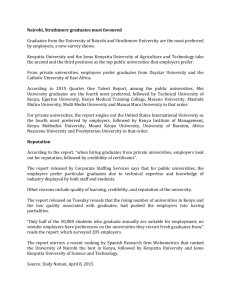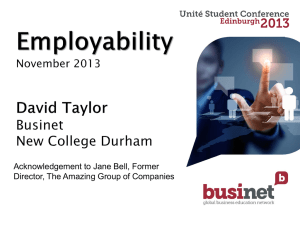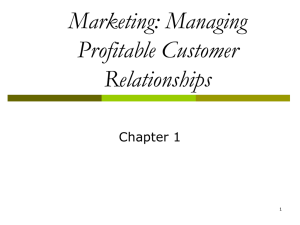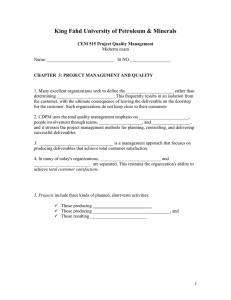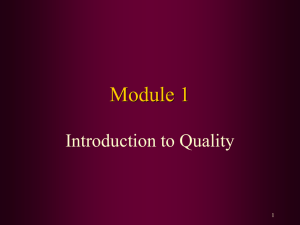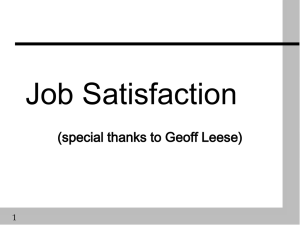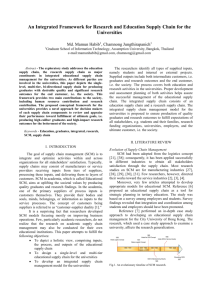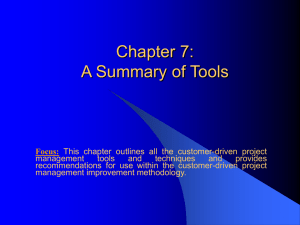YOU ARE WELCOME - Obafemi Awolowo University
advertisement
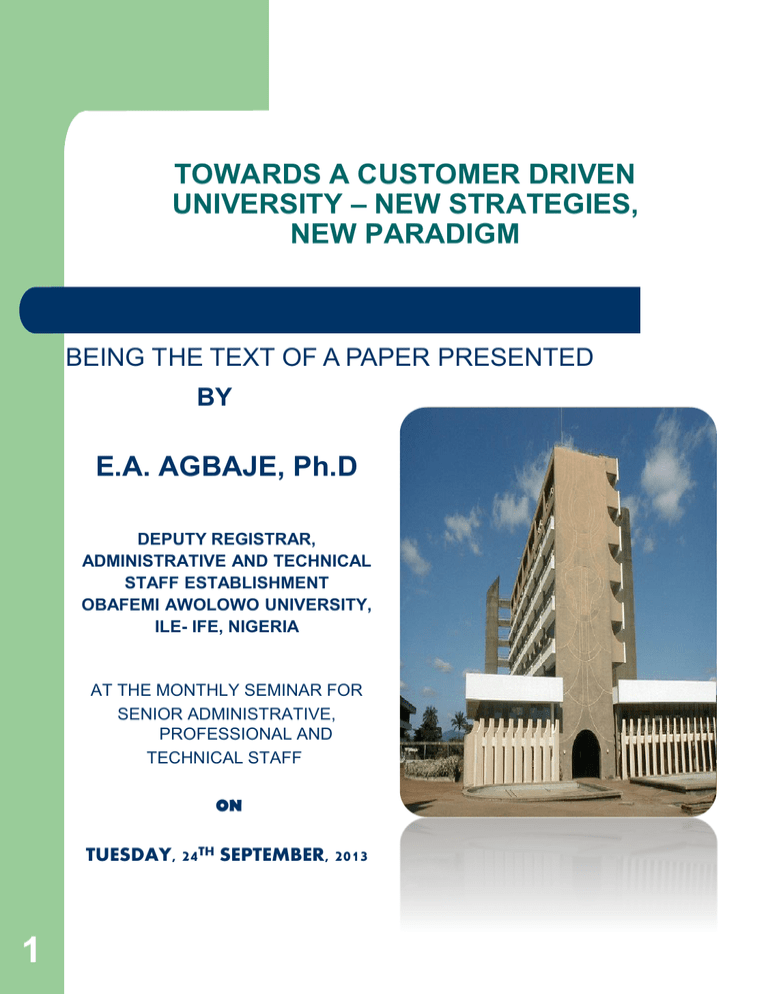
TOWARDS A CUSTOMER DRIVEN UNIVERSITY – NEW STRATEGIES, NEW PARADIGM BEING THE TEXT OF A PAPER PRESENTED BY E.A. AGBAJE, Ph.D DEPUTY REGISTRAR, ADMINISTRATIVE AND TECHNICAL STAFF ESTABLISHMENT OBAFEMI AWOLOWO UNIVERSITY, ILE- IFE, NIGERIA AT THE MONTHLY SEMINAR FOR SENIOR ADMINISTRATIVE, PROFESSIONAL AND TECHNICAL STAFF ON TUESDAY, 24TH SEPTEMBER, 2013 1 INTRODUCTION The best and brightest leaders/managers in any organization share one common secret: They put their customers first. They know that if you take care of your customer, success will follow. Peter Drucker has succinctly stated that: “There is only one valid definition of business purpose: to create a customer. He alone gives employment.” Decades of customer satisfaction research and its more sophisticated successors (customer relationship management, customer commitment or loyalty), have consistently on the central rationale: that it pays to understand the needs and wants of customers. Whoever disregards this important dictum does so at their peril. Thus, loyal customers, (usually defined as those who have a positive behavioural predisposition towards an organisation expressed, inter alia, by recommending a company to friends and families or buying more products or services), are the strongest possible foundation for a business. A customer (sometimes known as a client, buyer, or purchaser) is the recipient of a good, service, product, or idea, obtained from a seller, vendor, or supplier for a monetary or other valuable consideration (Reizenstein, 2004, Kendall, 2007). Customer service is series of activities designed to enhance the level of customer satisfaction – that is, the feeling that a product or service has met the customer’s expectation (Turban, Lee, King, and Chung, 2002). Customer service is performed in most of our educational institutions today and there are even departments dedicated to providing such services (e.g. Division of Students Affairs). The fact that institutions of higher education need students to survive and thrive cannot be overemphasized. Hence, Bejou (2005) has argued that “the longer these ongoing transactions are satisfactory to both parties, the longer the relationship will endure, to the benefit of everyone”. To better serve students, Ewers (2010) has suggested that institutions should expose employees to customer service training sessions to learn the basics of customer service. 2 Customer driven concept is a paradigm shift in business assumptions that recognized customers as the central figures in business successes and also enable the organizations to implement important structural changes designed to meet the needs of their customers – both external and internal. Although customer-driven is a business concept, research has shown that it could be applied to any field or industry that has internal or external customers. This paper would explores the need for customerfocused university and suggests practical strategies and tools necessary for building a customer-driven university. RATIONALE FOR CUSTOMER-DRIVEN UNIVERSITY University world-over was set up for a purpose, namely, teaching, research and services. For all the three major functions performed by the University are distinct customers, which are however, mutually inclusive. The primary customer for teaching function is students while customer for research products and services include students and public - governments, business and end-users consumers. The world-class institution of today stands on the shoulders of those who invests in the quality of its programmes, and could make difficult decisions, take calculated risks to move institutions forward, even in a difficult time and profound changes to almost every facet of its works. For our universities to compare favourably with similar institutions worldwide, there is need for innovation that would have positive impact on students and the world they inherit. Nigerian Universities were reputed for their high quality graduates between 1960 and mid-1980s. But, at present the standard of graduates have fallen owing to some factors including poor funding, inadequate teaching facilities, frequent disruption in school calendar leading to their deficiency in skills and expertise. For our university system to succeed in weathering through the storm of rapid and complex changes within the environment during the 21st century, it is essential for its management to build an administrative infrastructure that could be optimized for excellent service delivery, speed of work processes, quality assurance, high level of productivity and customer satisfaction. 3 It is therefore important to take step on the ways to move universities to the next level so that through adoption of international best practices that would improve the service delivery of both the academia and the administrative and technical staff in the institutions to their customers. UNIVERSITY CUSTOMERS AND THEIR EXPECTATIONS The primary customers of university education are students and their parents/guardians. Other customers include the Government and their agencies, the Business world and the public or larger society. With the rapid growth in population, social problems and emerging knowledge-based economy, government depends on higher education including universities to transmit the shared values and knowledge that would shape capable individuals, organized communities and the larger society. Thus, access to advanced education and training is critical to the life prospects of citizenry and to the national economy. Business relies on higher education institutions especially, universities as sources of getting skilled employees. Business community depends more on a capable, welleducated work force. Hence, individuals preparing to enter that work-force and workers already in it need higher, more relevant technical knowledge and intellectual skills to perform excellently well and contribute to the business successes. However, what business wants from higher education for its workers are the same things that individuals want from higher education for themselves, their families and their communities. Achieving customer service excellence begins with an overview of the industry, and developing a model for successfully communicating with customers while providing outstanding service. Managing customer experience is central to success in business. Through evaluation of the experiences with customers, it might be necessary to review procedures and policies and transform them into customer focused ones. 4 In the business world, when it comes to excellence, the only opinion that really matters is the customer’s opinion. This is because it is the customer who decides where they would buy, how often and whether or not they would recommend you. However, this may not be totally true for service and not-for-profit organisation like the university. Nevertheless, all organisations that have customers, need to keep customers, build market share and improve the performance of the entire workforce so that they would develop a culture of delivering superior service. ISSUES AND CHALLENGES There is a widely held concern whether higher education is adequately meeting the demands for the workforce that comprise talented and wellrounded individuals with an understanding of human experience, a shared sense of community, contructive values, intellectual curiosity, critical thinking skills, and the ability to communicate and work with other people. The employers want people who are hard working and dependable, who writes and speaks well, who are skilled in mathematics and problem solving, who are creative and flexible, eager to learn, and able to work in teams. These individuals are also the hallmarks of employees who make businesses more competitive and successful. Universities in Nigeria are often perceived to be more out of touch with their markets and are failing to meet important needs of their customers. Too many students have little assurance that what they learn in school would enable them to secure a good job or perform effectively once employed. Too many employers have no confidence that a degree represents the skills, knowledge, and work habits they expect from each employee in order to remain competitive. Graduates have been found with fundamental deficiencies in basic skills, social skills and work ethic. They also possesses outdated or unrealistic knowledge in the specialties for which they were trained in the University. Most continuing education programmes are also out of touch with fields of knowledge or unwilling to accommodate the schedules of working adults. University managers often forget that workplace is changing across all business sectors and work force quality is the key to competitive success in business. Access to higher education by those who are qualified is low and carrying capacity of all universities is yet to be expanded due to insufficient funding and inadequate infrastructure. 5 While some employers seek very talented or specialized new graduates to hire for responsible entry positions, most prefer experienced candidates which are hard to get. The lack of graduates that meet high standards for field-specific knowledge and high standards of proficiency in research, reasoning, problem solving, mathematics, writing, oral communication and teamwork has led to many employers placing graduates in low-wage entry jobs and promoting them only after they have proven themselves. Nevertheless, the growing demands for higher education, especially university education should be viewed in a positive perspective as great opportunity to expand and improve service delivery if government would allow each university to source for fund without encumbrances and grant them full autonomy. The overriding principle is for the university system to realize that it must be market oriented if its efforts to serve job aspirants, businesses, and employees would be successful. This imply that universities should reach out to the market, take classes to the customer site, offer flexible hours, understand business environment, keep up with real-world developments in the courses they do offer, and engage in consultancy and as a resource industry figures who are acknowledged experts in their field of study or centre of excellence. 6 STRATEGIES FOR CUSTOMER DRIVEN APPROACH The need for enhancing and promoting a customer focused culture are essential within the university sector because of the nature of the various categories of their customers. It is necessary to build a business based university that aims at improving outstanding levels of customer service and satisfaction, increase customer loyalty and retention through the integration of many different parts of the university business, staff hierarchies in academics, administrative and technical cadres and resources. Customers should be treated appropriately with complete satisfaction. Ensuring buy-in to the concept and benefits of adopting a solid, customer driven orientated approach to service delivery implies that the university engage its staff in developing the necessary fundamental skills required to understand, practice and deliver service excellence in a manner that ensures positive customer experiences and solidifies customer loyalty. Such efforts, on the part of the university will include the followings: 7 a. Become thoroughly customer driven – in both philosophy and organisational behaviour by: Establishing the key ingredients for implementing a strong service culture; Identify and overcome existing service barriers; Identify both internal and external customer and adopt skills to maximise relationships with both; Develop a customer-Centric Mindset; Knowing customers and their expectations; Develop customer friendly attitude; Calm upset customers and avoid upset situations as much as possible; Integrate all aspects of the university operation to manage and exceed customer expectations; Identify best practice in managing different customer situation including complaints; Develop, motivate and inspire customer-value staff to deliver high quality consistently; Overcome internal communication barriers and strengthen internal mechanisms for resolving grievances. 8 b. Conduct an Analysis of the University’s ability to be customerdriven including: i. Develop a list of core beliefs and corresponding behaviors or practices required for a customer-driven university; ii. Conduct an assessment to determine the alignment of the university’s beliefs and practices with becoming a customer-driven organization; iii. Apply key concepts and tools of process management and the customer-driven organizations to analyzing systems and processes and making process improvements; iv. Align vision, mission, goals, strategies, and standards with customer needs and expectations; v. Assess the university’s current methods for developing employees and star performers (if any), making recommendations for improvement; vi. Design an organizational strategy for measuring customer service and recognizing outstanding performance and setting benchmark; vi. Plan strategies for better use of assessment as a way to reward and recognize outstanding customer service. 9 c). Adopt quality standards so that employers and graduates themselves have assurance that a degree represents a high, competitive level of knowledge and skills. d). Improve greater access to and utilization of the university system by qualified candidates. e). Offer more practicum experience to students, and possibly faculty members, too, to make course work more relevant to real work and to give more new graduates the practical experience that employers prefer. (f). Expand the availability of customized and schematized continuing education and training needed to meet the large and growing demand for technical and highly skilled personnel for the various industries, especially high technology industries. In a nutshell, meeting these requirements will call for changes in mind set, operation, and curriculum content in university education. It may also require changes in institutional structure. 1 0 CONCLUDING REMARKS The adoption of customer-driven administrative style in the Obafemi Awolowo University is overdue. Providing a true service-centered environment is everyone’s job. Emphasis must start at the top and the inspiration for delivering has to be more than lip service. One way to accomplish this feat is to place a renewed focus on meeting or exceeding the expectation and needs of our customers, especially students. This is require to further raise the status of the institution to world class African University. The next generation of the university employees must possess the requisite knowledge, skills, behaviour and attitude that will improve service delivery to the customers of the University - both national and international communities. 1 1 THANK YOU FOR LISTENING Discussion Comments, etc. 1 2 REFERENCES Bejou, D. (2005). Treating students like customer, Biz Ed Magazine, March/April. Retrieved from http://www.aacsb.edu/publications/Archives/marapr05-toc.asp. Berry, L.L. and Parasuraman, A. (1991). Marketing Services – Competing through Quality, The Free Press, New York. Boyd, R.L. (2012). Customer Service in Higher Education: Finding a Middle Ground. Retrieved from http://dus.psu.edu/mentor/2012/06/customer-servicein-higher-education/#sthash.HSfFwUri.dpuf Brookes, M. (2003). “Higher education: Marketing in a quasi-commercial service industry”, International Journal of Nonprofit and Voluntary Marketing, Vol. 8, No.2, pp.134-142. Conway, T. and Swift, J.S. (2000). “International relationship marketing – The importance of psychic distance”, European Journal of Marketing, Vol. 34, No. 11/12, pp. 1391-1413. Driscoll, C. and Wicks, D. (1998). “The Customer-Driven Approach in Business Education: A Possible Danger?” Journal of Education for Business, Sept/Oct, pp.58-61. Drucker, P. (2004). “The Daily Drucker: 366 Days of Insight and Motivation for Getting the Right Things Done”, Collins Business, October. 1 3 Elliott, K.M. and Shin D. (2002). “Student Satisfaction: an alternative approach to assessing this important concept”, Journal of Higher Education Policy and Management, Vol. 24, No. 2, pp. 199-209. Reference cont. • • 1 4 Emery, C. Kramer, T. and Tian, R (2001). Customers vs. products: Adopting an effective approach to business students. Quality Assurance in Education, 9(2), pp. 110-115. Retrieved from http://www.bus.Isu.edu/accounting/faculty/lcrumbley/customersVSproducts.htm. Ewers, J. (2010). Using good customer service in higher education marketplace [weblogpost], April. Retrieved from http://diverseeducation.com/blogpost/238. Gengler, C. and Popkowski, P.T.L. (1997). “Using Customer Satisfaction Research for Relationship Marketing: A Direct Marketing Approach”, Journal of Direct Marketing, Vol.11, No.1, Winter. Hill, F.M. (1995). “Managing service quality in Higher Education: the role of the student as primary consumer”, Quality Assurance in Education, Vol. 3, No. 3, pp. 1021. Kendall, Stephanie D. (2007). "Customer Service from the Customer's Perspective". In Fogli, Lawrence. Customer Service Delivery: Research and Best Practices. J-B SIOP Professional Practice Series 20. John Wiley and Sons, pp. 3 Owlia, M.S. and Aspinwall, E.M. (1997). “TQM in higher education – a review”, International Journal of Quality and Reliability Management, Vol. No. 5, pp.527-543. Pereira, M.A.C. and Da Sliva, M.T. (2003). “A Key Question for Higher Education: Who are the customers”? Proceedings of the 31st Annual Conference of the Production and Operations Management Society, POM-2003, April 4-7, Atlanta, GE. Reizenstein, Richard C. (2004). "Customer". Encyclopedia of health care management. Sage eReference. SAGE. ISBN 978-0-7619-2674-0, pp. 119. Tahir, R. and Razak, R. (2006), “Customer satisfaction: Relationship Marketing in Higher Education E-Learning”, Innovative Marketing, Vol. 2, Issue 3. Tonks, D. and Farr, M. (1995) “Market segments for Higher Education: using geodemographics”, Marketing Intelligence and Planning, Vol. 13, No. 4, pp. 24-37. Turban, E., Lee, J., King, D, and Chung, H. (2002). Electronic commerce: A managerial perspective (International Ed.). Upper Saddle River, NJ: Prentice-Hall International.
